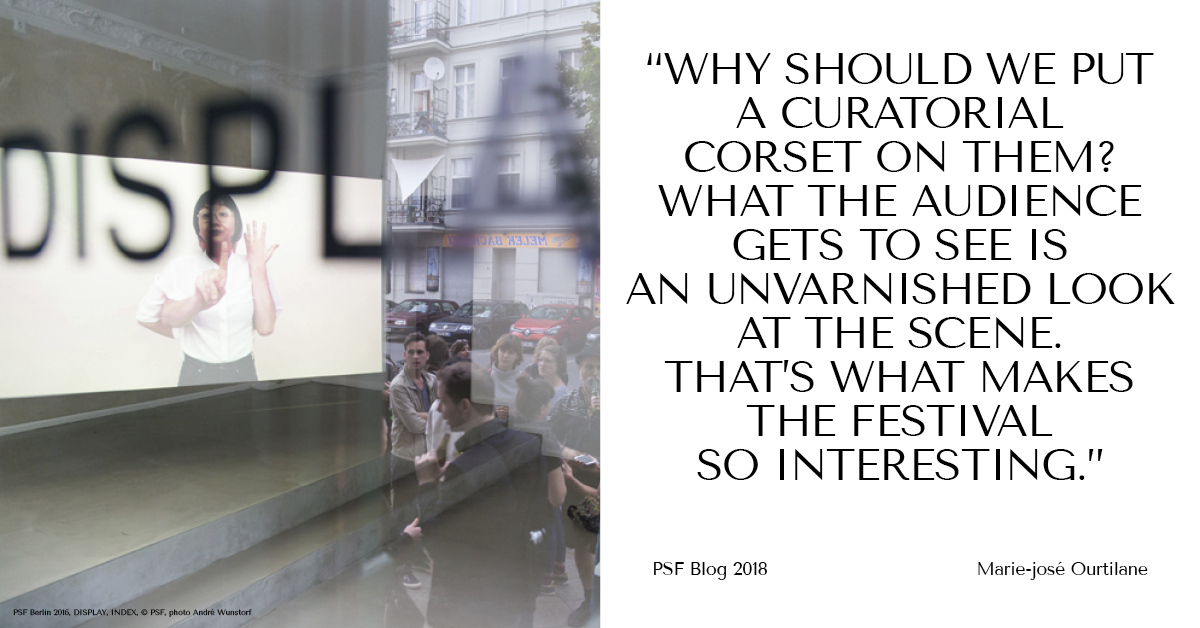
This year marks the 4th iteration of the Project Space Festival. In an interview with the PSF Blog, the festival’s director Marie-josé Ourtilane and assistant director Cora Hegewald speak about courage to experiment, journeying to the edges of the city, and the importance of the festival to Berlin’s cultural calendar.
After a break last year, the festival returns this August. What can visitors expect?
Marie-josé: It’s the fourth edition of the festival this year and, as in previous years, the festival can be seen as a journey through the world of Berlin’s project spaces. Visitors can get an idea of how the spaces work and think, and how they interact with the city, as well as learning more about the subjects and projects that they work on – it’s really an overview on the whole breadth of the scene. The participating spaces are mainly united by what they don’t want to be, that is: neither commercial, nor institutional. There’s plenty of courage to experiment aesthetically, and the spaces are a huge impulse for the city’s artistic landscape. That’s what we want to show to audiences.
The city’s art calendar is full with major events such as Gallery Weekend und Berlin Art Week. Is there still a gap for the festival to fill?
Cora: Absolutely. Spring and autumn belong to the commercial and established art world here in Berlin. With the coming of the festival in August, we are turning the attention toward a totally different scene. It’s all about the independent art spaces, a scene that is incredibly dynamic – it changes fast, and is very fragmented. The festival is a great opportunity to get a sense of what’s happening here once a year – for the project spaces themselves, which get to see the work of their contemporaries, but primarily for the wider audiences. Apart from that, the festival also closes a gap within the independent art scene itself, adding an important element to the work of Berlin’s two other main platforms: the political advocacy group Netzwerk freier Berliner Projekträume und -initiativen, and the senate’s initiative to recognise the work of project spaces, the Project Space Award.
Marie-josé, you spoke of the festival as a journey. Like previous editions, this year’s programme again spreads throughout the whole city. How important to the festival is this wide coverage?
Marie-josé: On the one hand, we’ve got the festival headquarters at ACUD MACHT NEU, where visitors can find more information about the festival in a specifically designed display by Julien Villaret. On the other hand, we really move beyond Mitte, into the verges of the city – to Pankow, Siemensstadt, or Hellersdorf. The selection jury always had one eye on the location of the spaces, trying to capture the diversity of the city. That’s key to us.
Cora: While we’re on the subject of geography, perhaps the festival is a bit of a seismograph: the art scene increasingly moves into the peripheries like Hellersdorf and, with the festival, and we are able to accompany this movement – perhaps we catch onto this a little earlier than others, even. It’s definitely nice that there’s more to see at the festival than the main clusters in Kreuzkölln und Mitte, which are, in an art context, already familiar. It’s not just one big cloud in a single district.
Are there topics and subjects that are at the centre of the scene’s attention this year? Is there on overarching theme?
Cora: First and foremost, there is this great diversity that Marie-josé mentioned earlier. It’s impossible to summarise the whole festival under a single theme. Even so, it occurred to us that a lot of the contributions deal with space in its various forms: mental, geographic, imagined, digital space. And there’s a lot of inquiry into the concept of connections in all its different manifestations – connections between artistic practices, between places and ideas. There’s a great attempt to bridge the gaps, which we find very exciting.
Marie-josé: The festival is not a traditional curatorial project; there are no thematic guidelines from us. If you ask me, that would be impossible anyway. All these spaces understand themselves as independent – independent from commercial considerations, and from political regulation. Why should we put a curatorial corset on them? What the audience gets to see is an unvarnished look at the scene, in all its breadth and diversity. That’s what makes the festival so exciting.
—
Interview: Manuel Wischnewski
